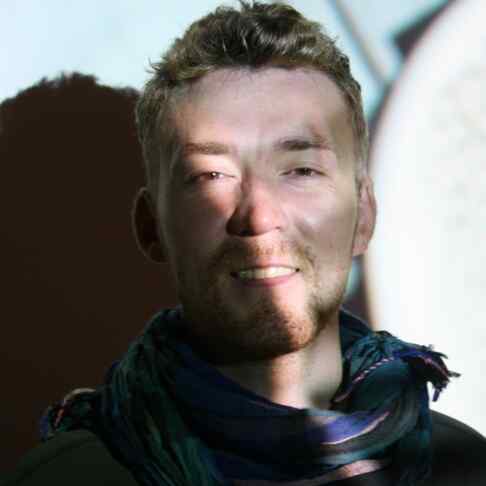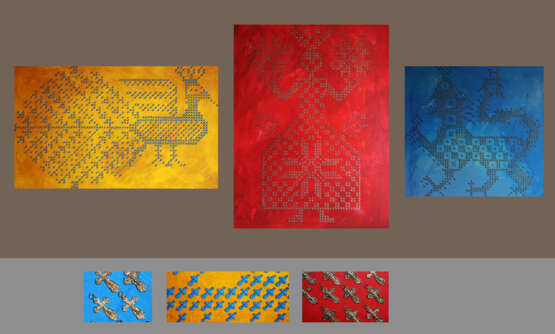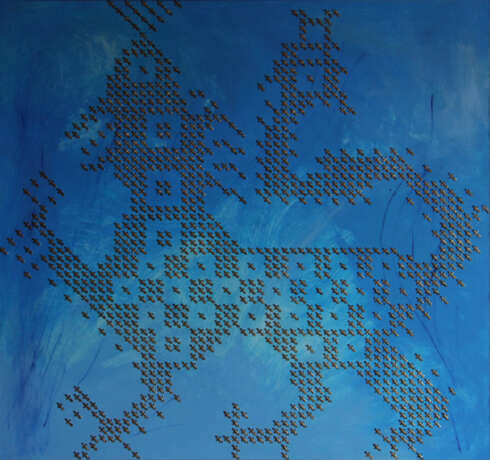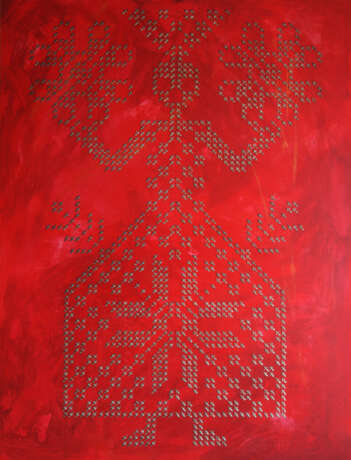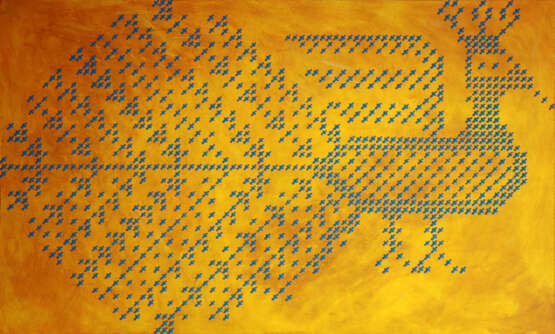Cross stitch Set aus 3 Stk. Hartfaserplatte Gemischte Technik Russland 2013
The presented triptych is a synthesis of the Slavic beliefs and Christian symbolism.
The motive. It is in the protecting embroidery and the save value of a pectoral cross.
The color. There are three main spectral colors - red, blue and yellow, the mixture of which precedes the birth of a new palette.
The image. It is in the indivisible interpretation of the divine.
The evolution of religious beliefs is not a full change of some forms by others but the stratifying a new layer onto an old one.
The Central figure of the triptych is Makosh who reflects the pairing of the submission of the Russian people about the world. According to the popular beliefs Makosh weaves two threads of fate, the thread of life and the thread of death. Makosh’s composition always has a tripartite structure. There is Makosh in the center of the composition and along the edges there is a pair through whom the duality and the opposition of the concepts of truth and falsehood, happiness and unhappiness, life and death, etc. transmit over. That being part of the uniform of a General is always located on the different sides of Makosh.
Slavic beliefs, rituals, and symbology that had been formed for thousands of years could not disappear immediately after the adoption of the new faith. There were not significant fundamental differences in the new and the old. And in heathenism and in Christianity the common Lord of the universe was confessed. There were invisible forces of the lower levels, rites with spell (worship). And there and here there was the concept of the soul and its immortality.
Therefore the change of faith considered not as a change of beliefs but the change of the form of ritualism and the replacement of the deities’ names.
The motive. It is in the protecting embroidery and the save value of a pectoral cross.
The color. There are three main spectral colors - red, blue and yellow, the mixture of which precedes the birth of a new palette.
The image. It is in the indivisible interpretation of the divine.
The evolution of religious beliefs is not a full change of some forms by others but the stratifying a new layer onto an old one.
The Central figure of the triptych is Makosh who reflects the pairing of the submission of the Russian people about the world. According to the popular beliefs Makosh weaves two threads of fate, the thread of life and the thread of death. Makosh’s composition always has a tripartite structure. There is Makosh in the center of the composition and along the edges there is a pair through whom the duality and the opposition of the concepts of truth and falsehood, happiness and unhappiness, life and death, etc. transmit over. That being part of the uniform of a General is always located on the different sides of Makosh.
Slavic beliefs, rituals, and symbology that had been formed for thousands of years could not disappear immediately after the adoption of the new faith. There were not significant fundamental differences in the new and the old. And in heathenism and in Christianity the common Lord of the universe was confessed. There were invisible forces of the lower levels, rites with spell (worship). And there and here there was the concept of the soul and its immortality.
Therefore the change of faith considered not as a change of beliefs but the change of the form of ritualism and the replacement of the deities’ names.
| ID: | 45712 |
|---|---|
| Künstler: | Rustam Nazirov (geb. 1975) |
| Zustand: | Neu |
| Herstellungsjahr: | 2013 |
| Angewandte Technik: | Gouache, Gemischte Technik |
| Material: | Hartfaserplatte |
| Größe: | 420 x 160 x 3 cm |
| Herkunftsort: | Russland |
| Kategorie: | Modulares Bild |
| Schlüsselwörter: | Kultig |
Informationen zum Künstler
